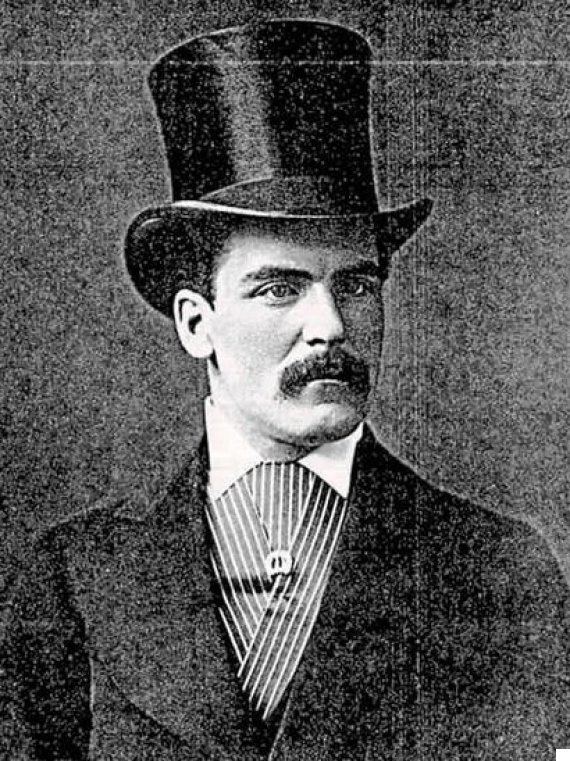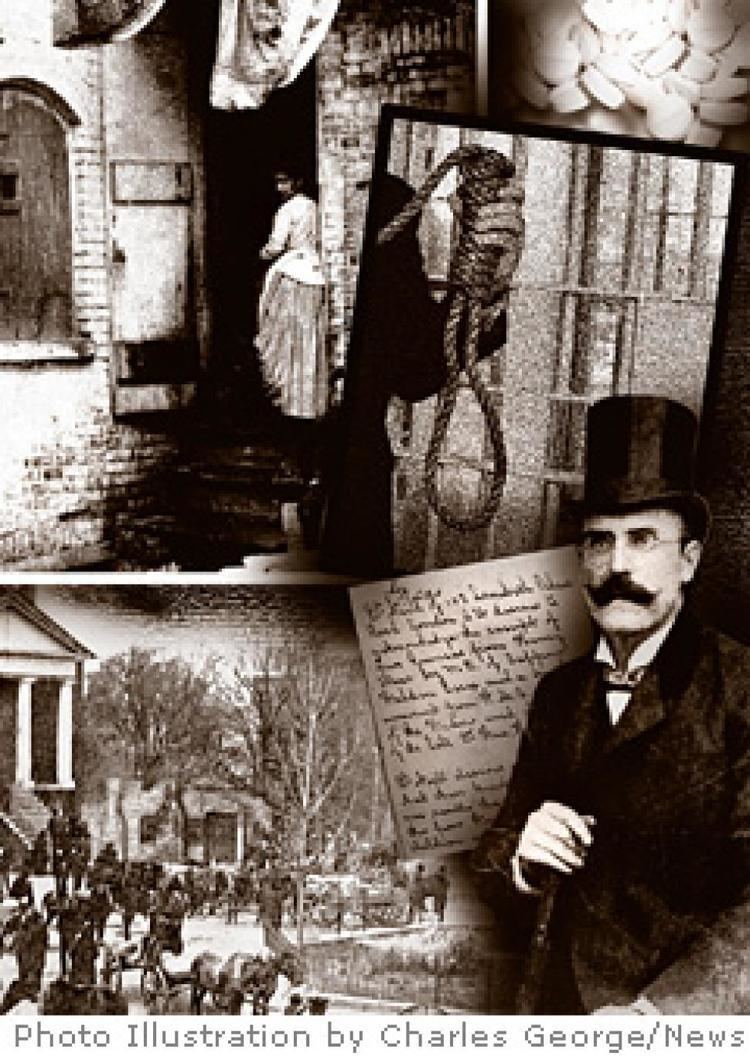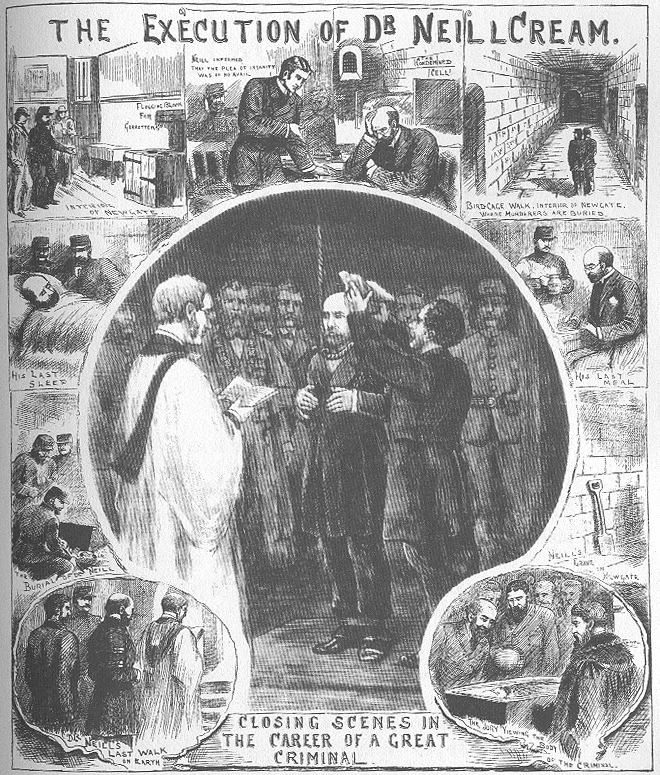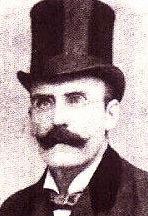Name Thomas Cream Date apprehended July 13, 1892 Country U.S., England | Span of killings 1881–1892 Victims 5 (known) Role Serial Killer | |
 | ||
Other names Dr. Thomas Neill, The Lambeth Poisoner Died November 15, 1892, Newgate Prison | ||
Cause of death Execution by Hanging Criminal penalty Capital punishment | ||
Thomas Neill Cream | Serial Killer Documentary
Dr. Thomas Neill Cream (27 May 1850 – 15 November 1892), also known as the Lambeth Poisoner, was a Scottish-Canadian serial killer, who claimed his first proven victims in the United States and the rest in England, and possibly others in Canada and Scotland. Cream, who poisoned his victims, was executed after his attempts to frame others for his crimes brought him to the attention of London police.
Contents
- Thomas Neill Cream Serial Killer Documentary
- Episode 9 serial poisoners ripper suspects george chapman thomas neill cream
- Early life
- Chicago
- London
- Capture
- Trial and execution
- Aftermath
- I am Jack The
- Analysis
- Representations in popular culture
- References

Unsubstantiated rumours suggested his last words as he was being hanged were a confession that he was Jack the Ripper—even though he was supposed to be in prison at the time of the Ripper murders.

Episode 9 serial poisoners ripper suspects george chapman thomas neill cream
Early life

Born in Glasgow, Cream was raised outside Quebec City, Canada, after his family moved there in 1854. He attended McGill University in Montreal and graduated with an MDCM degree in 1876 (his thesis topic was chloroform). He then went for post-graduate training at St Thomas's Hospital Medical School in London.
In 1876, Cream married Flora Brooks, whom he had impregnated and almost killed while aborting the baby. Flora died, apparently of consumption, in 1877, a death for which Cream would later be blamed.
Cream went to London in 1876 for post-graduate study at St. Thomas' Hospital, and in 1878 obtained additional qualifications as a physician and surgeon in Edinburgh. He then returned to Canada to practise in London, Ontario.
In August 1879, Kate Gardener, a woman with whom he was alleged to have had an affair, was found dead in an alleyway behind Cream's office, pregnant and poisoned by chloroform. Cream claimed that she had been made pregnant by a prominent local businessman, but after being accused of both murder and blackmail, Cream fled to the United States.
Chicago
Cream established a medical practice not far from the red-light district in Chicago, offering illegal abortions to prostitutes. He was investigated in August 1880 after the death of Mary Anne Faulkner, a woman on whom he had allegedly operated, but he escaped prosecution due to lack of evidence.
In December 1880 another patient, Miss Stack, died after treatment by Cream, and he subsequently attempted to blackmail a pharmacist who had made up the prescription.
In April 1881, a woman named Alice Montgomery died of strychnine poisoning following an abortion in a rooming house barely a block from Cream's office. The case was ruled a murder but never solved. The location, time period, and method make Cream a likely suspect.
On 14 July 1881, Daniel Stott died of strychnine poisoning at his home in Boone County, Illinois, after Cream supplied him with an alleged remedy for epilepsy. The death was attributed to natural causes, but Cream wrote to the coroner blaming the pharmacist for the death after again attempting blackmail. Cream was arrested, along with Mrs. Julia A. (Abbey) Stott, who had become Cream's mistress and procured poison from Cream to do away with her husband. She turned state's evidence to avoid jail, laying the blame on Cream, which left him to face a murder conviction on his own. He was sentenced to life imprisonment in Joliet Prison.
One night unknown persons erected a tombstone at Mr. Stott's grave which read,
Daniel Stott Died June 12, 1881 Aged 61 Years, poisoned by his wife and Dr. Cream.
Cream was released in July 1891. Governor Joseph W. Fifer had commuted his sentence after Cream's brother pleaded for leniency and allegedly bribed the authorities.
London
Using money inherited from his father, who had died in 1887, Cream sailed for England, arriving in Liverpool on 1 October 1891. He returned to London and took lodgings at 103 Lambeth Palace Road. At the time, Lambeth was ridden with poverty, petty crime, and prostitution.
On 13 October 1891, Ellen "Nellie" Donworth, a 19-year-old prostitute, accepted a drink from Cream. She was severely ill the next day and died on 16 October from strychnine poisoning. During her inquest Cream wrote to the coroner offering to name the murderer in return for a £300,000 reward. He also wrote to W. F. D. Smith, owner of the W H Smith bookstalls, accusing him of the murder and demanding money for his silence.
On 20 October, Cream met with a 27-year-old prostitute named Matilda Clover. She became ill and died the next morning; her death was at first attributed to her alcoholism. Cream wrote a note to the prominent physician Dr. William Broadbent accusing him of poisoning Matilda Clover and demanding cash. Broadbent sent his letter to Scotland Yard.
On 2 April 1892, after a vacation in Canada, Cream was back in London where he attempted to poison Lou Harvey (née Louise Harris) who, being suspicious of him, pretended to swallow the pills he had given her. She secretly disposed of them by throwing them off a bridge into the River Thames.
On 11 April, Cream met two prostitutes, Alice Marsh, 21, and Emma Shrivell, 18, and talked his way into their flat where he offered them bottles of Guinness. Cream left before the strychnine he had added to the drinks took effect. Both women died in agony.
Capture
Through his accusatory letters, Cream succeeded in drawing significant attention to himself. Not only did the police quickly determine the innocence of those accused, but they realised there was something significant within the accusations made by the anonymous letter-writer: he had referred to the murder of Matilda Clover. In fact, Clover's death had been registered under natural causes, related to her drinking. The police quickly realised that the false accuser who had written the letter was the serial killer now referred to in the newspapers as the 'Lambeth Poisoner'.
Not long afterward, Cream met a policeman from New York City who was visiting London. The policeman had heard of the Lambeth Poisoner, and Cream gave him a brief tour of where the various victims had lived. The American happened to mention it to a British policeman who found Cream's detailed knowledge of the case suspicious.
The police at Scotland Yard put Cream under surveillance and soon discovered his habit of visiting prostitutes. They also contacted police in the United States and learned of their suspect's conviction for a murder by poison in 1881.
On 3 June 1892, Cream was arrested for the murder of Matilda Clover, and on 13 July he was formally charged with the murders of Clover, Donworth, Marsh, and Shrivell, the attempted murder of Harvey, and extortion. From the start he insisted he was only Dr. Thomas Neill, not Dr. Thomas Neill Cream, and the newspapers usually referred to him as Dr. Neill in their coverage of the proceedings.
Trial and execution
His trial lasted from 17 to 21 October that year. After a deliberation lasting only 12 minutes, the jury found him guilty of all counts, and Justice Henry Hawkins sentenced him to death.
Less than a month after his conviction, on 15 November, Cream was hanged on the gallows at Newgate Prison by James Billington. As was customary with all executed criminals, his body was buried the same day in an unmarked grave within the prison walls.
Aftermath
His name does not appear in later McGill graduate directories.
"I am Jack The..."
Billington claimed that Cream's last words on the scaffold were "I am Jack The..." Billington promoted this alleged incident as proof that he was responsible for executing the notorious Victorian serial killer Jack the Ripper.
These claims remain unsubstantiated, as police officials and others who attended the execution made no mention of any such event. Moreover, records show Cream was in prison at the time of the Ripper murders in 1888, so it would have been impossible for him to be the culprit. However, Donald Bell suggested that Cream could have bribed officials and left the prison before his official release, and Sir Edward Marshall-Hall suspected that his prison term may have been served by a look-alike in his place. Such notions are unlikely and contradict evidence given by the Illinois authorities, newspapers of the time, Cream's solicitors, Cream's family, and Cream himself.
One of Cream's biographers suggested that Cream, on the scaffold and about to be hanged, was so frightened that he lost control of his bodily functions and stammered "I am ejaculating", which could have been mistaken for "I am Jack".
English-Canadian writer Chris Scott won an Arthur Ellis Award for Best Crime Novel in 1989 for Jack, a novel based on the premise that Cream actually was Jack the Ripper.
Analysis
The motivation for the series of poisonings has never been settled. It has generally been assumed that Cream was a sadist who enjoyed the thought of the agonies of his victims (even if he was not physically present to witness these). However, Cream was also interested in money, as evidenced by his attempts at extortion in almost all of his crimes, so it remains a possibility that he committed the murders under the pretense of ill-planned attempts to profit from them. From the start of the series of crimes Cream wrote blackmail notes to prominent people; and the poisoning of his one known male victim, Daniel Stott, was committed with the hope that Stott's wealthy widow would share the deceased's estate with Cream.
In addition to the five poisonings Cream was convicted for, he is suspected in the murder of his wife Flora Brooks in 1877, and at least four other women who died in his care while undergoing abortions.
Representations in popular culture
In the 2015 BBC One television series River, Cream appears frequently to and converses with D.I. John River as a "manifest".
In the first episode (in 2000) of "Murder Rooms: Mysteries of the Real Sherlock Holmes," the young Conan Doyle and Dr Bell pursue a murder case that involves a Thomas Neill, played by the actor Alec Newman. At the end, a postscript further identifies him as Dr. Thomas Neill Cream, who attended medical school along side the real Arthur Conan Doyle.
